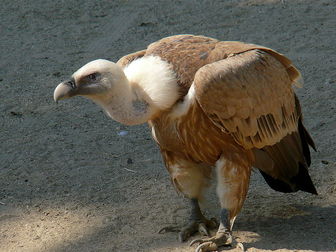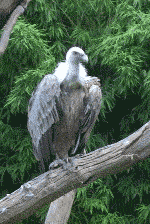Griffon Vulture
The Griffin Vulture is 93–110 cm long with a 230–269 cm wingspan, and it weighs between 6 and 13 kg . Hatched naked, it is a typical Old World vulture in appearance, with a very white bald head, very broad wings and short tail feathers. It has a white neck ruff and yellow bill. The buff body and wing coverts contrast with the dark flight feathers.

Original source: originally posted to Flickr as Griffon Vulture at Oakland Zoo
Author: Ingrid TaylarPermission(Reusing this file)This image, which was originally posted to Flickr.com, was uploaded to Commons using Flickr upload bot on 00:01, 19 January 2010 (UTC) by Snowmanradio (talk). On that date it was licensed under the license below. This file is licensed under the Creative Commons Attribution-Share Alike 2.0 Generic license.You are free:to share – to copy, distribute and transmit the work
Griffon vulture - A victim of industrial agriculture
 For quite a long time the industrial way of producing in modern agriculture is at issue. Besides ethical questions, risen by intensive livestock farming, the momentary discussion focuses on actual threads to human beings, like BSE, and what measures have to be taken, if economical losses are feared, like in the debate about foot-and-mouth disease. Other consequences of the industrial organization of our agriculture are not at all discussed or just perceived peripherally. One of these issues is the fact that not only domestic animals, serving us with their meat, milk and eggs, are affected, but also wild living animals suffer from the changes in agriculture. The Griffon vulture is an example for these species. Its basis for living has been destroyed by the vanishing of the traditional forms of agriculture in the cultivated European landscapes.
For quite a long time the industrial way of producing in modern agriculture is at issue. Besides ethical questions, risen by intensive livestock farming, the momentary discussion focuses on actual threads to human beings, like BSE, and what measures have to be taken, if economical losses are feared, like in the debate about foot-and-mouth disease. Other consequences of the industrial organization of our agriculture are not at all discussed or just perceived peripherally. One of these issues is the fact that not only domestic animals, serving us with their meat, milk and eggs, are affected, but also wild living animals suffer from the changes in agriculture. The Griffon vulture is an example for these species. Its basis for living has been destroyed by the vanishing of the traditional forms of agriculture in the cultivated European landscapes.
Certainly the traditional pastural agriculture was nothing but a secondary basis for living for the Griffon vultures; they already lived long before man settled down and started keeping domestic animals. Griffon vultures feed on carcasses of large animals, mostly on what has been left by large carnivores like Wolves and Bears. In contrast to America's "New world vultures", like the Condors, which are able to orientate themselves with their sense of smell, vultures of the Old World, like the Griffon vulture, rely completely on their excellent optical sense. Gliding at high altitudes, they are capable of interpreting the behaviour of a hunting pack of wolves and estimating, when and where they would find a carcass. But there haven't been hunting wolves and bears in our cultivated landscapes for quite a while now and Griffon vultures had to find other sources of nutrition. Animals perished in forest areas were out of question, since they are hard to detect from above. Open areas are more suitable and so the traditional pastural agriculture served as a good alternative. From time to time there have been dead animals on the pastures, which were not removed immediatelly or not at all detected by the farmers in inaccessible regions. These carcasses served the Vultures as an easily to access source of nutrition. On the other hand the Vultures played an important role in keeping the livestocks healthy, because they prevented pathogenes from spreading. But this traditional pastural agriculture is a thing of the past in most European regions nowadays. Most animals are kept in closed facilities all year. Where the cattle is still kept on pastures, there's not a great chance that a carcass is left long enough to be detected by Vultures. So the Griffon vulture and other Vulture species are not able to find enough food to stay permanently in our cultivated regions. In addition Vultures have been persecuted intensively as pests, although their presence has been very useful for the farmers.
The distribution range of the Griffon vulture extends from Northern Africa across the Iberian Peninsula and the rest of Southern Europe eastwards as far as Northern India. Because of the issues mentioned above, there are large distribution gaps in Europe. The Griffon vulture, as a species, isn't endangered, but it is vanished from a lot of its former breeding grounds. Griffon vultures inhabit open areas, especially mountainous regions. They are gregarious, nesting on rocks in large colonies. The pair normally incubates just one egg, quite scarcely two. The young Vulture grows very slowly and leaves the nest when more than 50 days old. It becomes sexually mature at an age of four to seven years. The low reproduction rate is balanced by the fact that Griffon vultures reach an old age. Within their lifespan of almost 40 years they produce many broods, if they find conditions that satisfy their needs.
This article was originally published at magazine.naturspot.de. Link to the original article
The Griffon Vulture is classified as Least Concern. Does not qualify for a more at risk category. Widespread and abundant taxa are included in this category.

Original source: Lin
Author: Lin
Permission: Some rights reserved
Family : Accipitridae
Genus : Gyps
Species : fulvus
Authority : (Hablizl, 1783)
